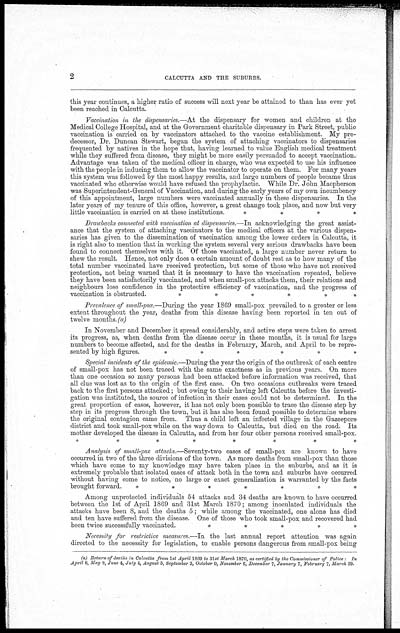Medicine - Vaccination > 1869-1873 - Report on vaccination in the Province of Bengal > Report on vaccination proceedings under the Government of Bengal with an appendix for the year ending 31st March 1870
(102) Page 2
Download files
Individual page:
Thumbnail gallery: Grid view | List view

2 CALCUTTA AND THE SUBURBS.
this year continues, a higher ratio of success will next year be attained to than has ever yet
been reached in Calcutta.
Vaccination in the dispensaries.—At the dispensary for women and children at the
Medical College Hospital, and at the Government charitable dispensary in Park Street, public
vaccination is carried on by vaccinators attached to the vaccine establishment. My pre-
decessor, Dr. Duncan Stewart, began the system of attaching vaccinators to dispensaries
frequented by natives in the hope that, having learned to value English medical treatment
while they suffered from disease, they might be more easily persuaded to accept vaccination.
Advantage was taken of the medical officer in charge, who was expected to use his influence
with the people in inducing them to allow the vaccinator to operate on them. For many years
this system was followed by the most happy results, and large numbers of people became thus
vaccinated who otherwise would have refused the prophylactic. While Dr. John Macpherson
was Superintendent-General of Vaccination, and during the early years of my own incumbency
of this appointment, large numbers were vaccinated annually in these dispensaries. In the
later years of my tenure of this office, however, a great change took place, and now but very
little vaccination is carried on at these institutions. * * * *
Drawbacks connected with vaccination at dispensaries.—In acknowledging the great assist-
ance that the system of attaching vaccinators to the medical officers at the various dispen-
saries has given to the dissemination of vaccination among the lower orders in Calcutta, it
is right also to mention that in working the system several very serious drawbacks have been
found to connect themselves with it. Of those vaccinated, a large number never return to
shew the result. Hence, not only does a certain amount of doubt rest as to how many of the
total number vaccinated have received protection, but some of those who have not received
protection, not being warned that it is necessary to have the vaccination repeated, believe
they have been satisfactorily vaccinated, and when small-pox attacks them, their relations and
neighbours lose confidence in the protective efficiency of vaccination, and the progress of
vaccination is obstructed. * * * * * *
Prevalence of small-pox.—During the year 1869 small-pox prevailed to a greater or less
extent throughout the year, deaths from this disease having been reported in ten out of
twelve months. (a)
In November and December it spread considerably, and active steps were taken to arrest
its progress, as, when deaths from the disease occur in these months, it is usual for large
numbers to become affected, and for the deaths in February, March, and April to be repre-
sented by high figures. * * * * * *
Special incidents of the epidemic.—During the year the origin of the outbreak of each centre
of small-pox has not been traced with the same exactness as in previous years. On more
than one occasion so many persons had been attacked before information was received, that
all clue was lost as to the origin of the first case. On two occasions outbreaks were traced
back to the first persons attacked; but owing to their having left Calcutta before the investi-
gation was instituted, the source of infection in their cases could not be determined. In the
great proportion of cases, however, it has not only been possible to trace the disease step by
step in its progress through the town, but it has also been found possible to determine where
the original contagion came from. Thus a child left an infected village in the Gazeepore
district and took small-pox while on the way down to Calcutta, but died on the road. Its
mother developed the disease in Calcutta, and from her four other persons received small-pox.
* * * * * * * *
Analysis of small-pox attacks.—Seventy-two cases of small-pox are known to have
occurred in two of the three divisions of the town. As more deaths from small-pox than those
which have come to my knowledge may have taken place in the suburbs, and as it is
extremely probable that isolated cases of attack both in the town and suburbs have occurred
without having come to notice, no large or exact generalization is warranted by the facts
brought forward. * * * * * * *
Among unprotected individuals 54 attacks and 34 deaths are known to have occurred
between the 1st of April 1869 and 31st March 1870; among inoculated individuals the
attacks have been 8, and the deaths 5; while among the vaccinated, one alone has died
and ten have suffered from the disease. One of those who took small-pox and recovered had
been twice successfully vaccinated. * * * * *
Necessity for restrictive measures.—In the last annual report attention was again
directed to the necessity for legislation, to enable persons dangerous from small-pox being
(a) Return of deaths in Calcutta from 1st April 1869 to 31st March 1870, as certified by the Commissioner of Police In
April 6, May 2, June 4, July 4, August 3, September 3, October 0, November 6, December 7, January 7, February 7, March 39.
Set display mode to: Large image | Zoom image | Transcription
Images and transcriptions on this page, including medium image downloads, may be used under the Creative Commons Attribution 4.0 International Licence unless otherwise stated. ![]()
| Permanent URL | https://digital.nls.uk/91534929 |
|---|
| Additional NLS resources: | |
|---|---|



![[Page 1]](https://deriv.nls.uk/dcn4/9153/91534928.4.jpg)
